October 2023 Vol. 78 No.10
Features
Groundbreaking advances made with EPBM tunnel constructed below sea level
Christine H. Kirby, P.E., ENV SP | Lockwood, Andrews and Newnam Inc.
(UI) — In response to a mandate issued by the Harris-Galveston Subsidence District (HGSD) to increase usage of surface water and decrease groundwater use, Houston Public Works created the Surface Water Transmission Program (SWTP).
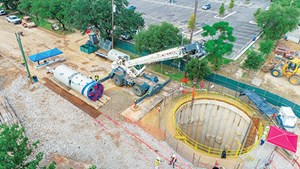
To aid in preventing future ground subsidence and alleviate infrastructure damage and flooding, the SWTP Program goals are to increase surface water usage, decommission and/or minimize the use of groundwater pump stations, increase water system pressures and address other large-diameter water line issues.
According to HGSD, groundwater use in the Houston region made up about 60% of total water use in 1976. In 2020, the percentage has dropped to 21%, and a 9% decrease in ground water pumping from 2019.
The SWTP 72-inch Water Line from Emancipation to Tuam is the first segment in a series of four that will serve as a refill line to the Southwest Pump Station (SWPS). After rupture of a 42-inch surface water refill line in 2004, the city evaluated vulnerability of supply to its three major repump stations.
SWPS is the heart of the system, and shutdown of the more than 50-year-old, 66-inch, pre-stressed concrete cylinder pipe (PCCP) – the current primary source – would impact the system’s ability to supply the western half of the city. A new 72-inch water line was initially identified as a secondary refill line but would become the primary supply line for SWPS and provide an opportunity to assess and rehabilitate the existing 66-inch water line.
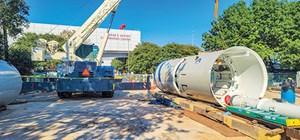
Preparing for the future
After a decade of astounding 21.6% population growth, the Houston region is expected to double its current population by 2050. This project was a major step in achieving the city’s increased resiliency goals to improve redundancy and reliability within its water transmission system.
In this densely urban part of Houston, with an average of over 170,000 vehicles per day recorded along this section of US-59, the 96-inch-diameter tunnel crossing under US-59 was considered a record-breaking tunnel installation. The 874-foot-long tunnel required shafts to be constructed to a 79-foot depth, which was 33 feet below sea level. For a tunnel of this scale, challenges of equal magnitude were faced throughout the design and construction process.
The project began at the intersection of Emancipation at Polk St. in East Downtown, and ended at the intersection of Tuam and Crawford, in Midtown. With a total of over 7,800 linear feet, the scope of work included a 72-inch water transmission line, full roadway reconstruction, major drainage improvements, traffic signalization improvements, street lighting improvements and sidewalk improvements.
Because of the TxDOT future freeway expansion, with a proposed depressed section and future drilled shaft retaining walls, the tunnel was designed at a depth to avoid future freeway improvements. The length of the tunnel was also designed so that the completed length would clear the future expanded freeway width.
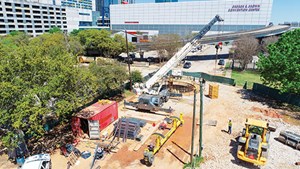
Part of the planning and design included thorough geotechnical exploration, which identified various soil conditions including fat clay, lean clay, sand with silt, sandy, silty clay and silty sand. A zone of hydraulically charged silty sands, also known as running sands, was discovered. With any type of trenchless application, there is a high risk of soil unraveling and difficulty controlling the groundwater in this type of soil.
While the tunnel invert depth was adjusted to a more suitable soil layer, the running sands would unavoidably be encountered as part of the shaft excavations on both the launch and receiving sides. Due to the depth and expected soil conditions, the contractor, Harper Brothers Construction LLC, selected a concrete secant pile shaft construction, which would create a water-tight shaft, similar to a coffer dam.
With the circular shafts being 44-foot outside diameter on each side of the tunnel, the inside diameter of 31 feet would provide the necessary working area needed to set and launch the tunnel boring machine. With a secant-pile shaft, the primary secant piles were initially driven, then the secondary secant piles were driven in an overlapping fashion among the primary secant piles for a completely integral and water-tight shaft. After the piles were in place, the contractor began excavating from the top.
“The highlight of the project was the secant pile shafts. The drilled secant shafts were 99 feet and 104 feet, which was pretty deep relative to other projects. It was an incredible tunneling project,” according to Corey Garnett, project manager at Harper Brothers. “A true partnering spirit was taken on between the contractor, the owner and the engineer, which was one reason why the project was successful.”
EPBM goes to work
After the shafts were completed and the bottom seal slab set in place, Harper Brothers used an earth-pressure balance machine (EPBM) with a soft ground cutter head designed for fat clay to excavate the tunnel under US59. The 96-in EPBM could work in open mode or closed mode by changing the primary conveyor type – which is either a belt conveyor (for non-pressurized conditions/open mode) or a screw conveyor (for the closed mode).
The face of the machine had foam injection ports for the injection of foam or slurry for muck conditioning that aids in controlled soil removal. The operator could choose the advance rate or the spoil removal rate, as necessary, to keep the earth pressure balance within the acceptable range. This prevents the soil and groundwater from entering the face of the tunnel in an uncontrolled manner.
As tunnel excavation progressed, the contractor used a steel ring beam and steel lagging support system designed to withstand external earth loading. Once the tunnel excavation was successfully completed and inspected, Harper Brothers lowered each 72-inch water line section into the shaft and pushed it into the tunnel, which is known as carrier pipe threading.
A pipe walkthrough of the tunnel carrier pipe was done to check for conformance with specifications. The annular space between the pipe and the shaft was grouted, and the shafts were backfilled to the surface.
The contractor faced unprecedented challenges with this project including the onset of the pandemic reaching the Houston area just one month after the construction notice to proceed was issued. Safety of field workers was the greatest priority. The team quickly adapted to new restrictions and safety protocols.
The project also faced material shortages, as a result of the pandemic. In addition, the project endured Texas’s historic Winter Storm Uri, when temperatures plunged to record lows in the Lone Star State. Without missing a beat, the contractor was proactive in ensuring materials – especially long lead items – arrived on schedule, to keep the project on track.
The Construction Notice to Proceed was issued in February 2020, and was substantially complete in August 2022.
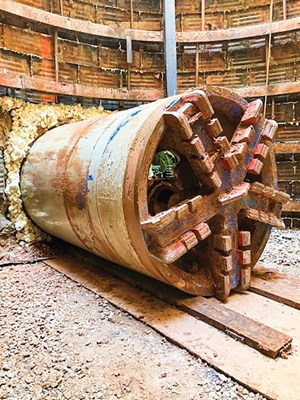
“Completion of historic 79-foot-deep tunnel with an invert level 33-feet below sea level was a result of exemplary engineering knowledge, construction skills, teamwork and project management,” said Singarpal Singh Sekhon, P.E., CCM, PMP, ENV SP, Houston Public Works project lead. “Continuous coordination, cooperation and communication among the contractor, engineer, project management team and other stakeholders helped to accomplish such a complex project within budget and minimal disruption.”
This project received the American Public Works Association Texas Chapter Project of the Year for Environments ($25 million to $75 million category). Houston’s legacy continues with its trail-blazing water infrastructure expansion initiatives.
Thanks to these initiatives, the city of Houston’s drinking water system maintains a “Superior” rating, the highest rating for water quality issued by the Texas Commission on Environmental Quality.
ABOUT THE AUTHOR: Christine Kirby, P.E., ENV SP with Lockwood, Andrews, and Newman Inc. (LAN), has more than 20 years of civil engineering experience specializing in water infrastructure. She has expertise with the development of specifications for pipe design, linings and coatings, as well as geotechnical review, environmental site assessment (ESA) preparation, route evaluations, right-of-way (ROW) acquisition assistance and private agency coordination. Kirby is the chair of two AWWA Committees and is a licensed professional engineer in seven states.
FOR MORE INFORMATION:
Lockwood, Andrews & Newnam (LAN) Inc., (713) 266-6900, lan-inc.com
Harper Brothers Construction LLC, (713) 893-4593, www.harperbro.com
Akkerman Inc., (800) 997-0584, akkerman.com



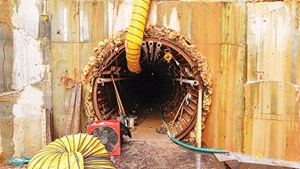

Comments